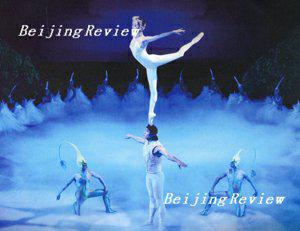Swan Lake Takes to the Sky
2006-12-11TANGYUANKAI
TANG YUANKAI
A new version of the classical ballet, re-invented as a Chinese acrobatic performance, begins an international tour this month with hopes of reinvigorating a sagging art form

EYE-INSPIRING PERFORMANCE: Acrobatic pantomime of Swan Lake is a totally new presentation of the ballet classic
Since Swan Lake debuted at Moscows Bolshoi Theatre in 1877--unpopular with audiences, only to reemerge successfully 18 years later--the ballet has been performed countless times and re-imagined by ballet companies worldwide. After the founding of the Peoples Republic of China in 1949, it was the first full-length ballet to be performed that featured Chinese dancers.
This month, a Chinese acrobatic troupe is reaching for the stars as it departs on an international tour with a high-flying rendition of the classic. This interpretation sees acrobats perform the pas de deux upside down and soar through the air to the strains of Tchaikovsky.
Choreographers of the new version of Swan Lake, described as “acrobatic ballet pantomime,” hope the longtime success of the original will rub off and reinvigorate Chinese acrobatics, a performance art that has largely lost its appeal to audiences.
The 135 performers in the new Swan Lake are gold medal-winning acrobats from the Guangzhou Military Acrobatic Troupe. Some are part of a competitive group that twice won the Golden Clown Prize at the Monte Carlo International Acrobatic Competition, a top prize in the world of acrobatics. The tour is financed by the Shanghai City Dance Co., with joint funding from the Shanghai Cultural Development Foundation and the Shanghai branch of China Everbright Bank.
This month, the troupe flew to Russia to perform at the Kremlin Theatre in Moscow on their first stop of a year-long tour that will see them give 300 international performances.
Unusual steps
In the original version of Swan Lake, the elegant swan ballerina is lifted up the prince above his head, but in the Chinese acrobatic performance, the female acrobat does a pirouette aloft on the princes shoulder and outstretched arm, and then rises en pointe on his head.
Wu Zhengdan and Wei Baohua, the two lead performers in the new Swan Lake, are the most popular acrobats in China and a happy couple, just like the prince and princess in the story they perform.
When Wei first met Wu, he was 16 and she was only six years old, and both were studying acrobatics at a sports school. In 1992 they began teaming up with each other for competitions.
If it were not for an accident, which ended their career in sports acrobatics, they would probably have become national champions. However, after the accident in which the two got injured, they received an invitation from the Guangzhou Military Acrobatic Troupe, making it possible for them to continue cooperation in a new arena. Ten years later, their stellar performance in the acrobatic ballet Oriental Swan won them the Golden Clown Prize at the International Circus Festival of Monte Carlo in 2002.
When the two performed during the 2001 Asia-Pacific Economic Cooperation forum in Shanghai, their Oriental Swan received wild applause from world leaders. More importantly, it inspired the director of their troupe, Ning Genfu, to conceptualize the acrobatic version of Swan Lake. Ning invited Zhao Ming, a choreographer from the Beijing Military Troupe, and Liu Jun, a choreographer employed at the time by the German Royal Ballet, to join him in the project.
Ballet with a twist
The unconventional combination of classical ballet and traditional Chinese acrobatics initially drew many doubts, as well as criticism that this radical reworking of Swan Lake would damage the original ballet.
To address concerns, choreographers established three principles for the transformation: maintain the elegant atmosphere of the original work, create a natural combination of acrobatics and the story, and ensure there is no damage to the original music.
The artistic composition of the acrobatic version took three years, during which time, in line with the original music by Tchaikovsky, the choreographers managed to combine aspects of the military acrobatic troupes gold medal programs with additional acrobatic techniques. At the beginning of 2004, rehearsals of the acrobatic Swan Lake began.
The rehearsals showed that a successful re-composition of the original ballet was a much harder job than previously thought. As a classical ballet, Swan Lake has widely recognized ways of expression and performance, and the problem facing the choreographers and acrobats was that they had to replace the existing steps with “acrobatic language,” which was yet to be created.
Although Chinese acrobatics have been around for more than 2,700 years, they developed at a slow pace, and it was not until the 1980s that this art form began to take overall artistic effect into account. It was only in the 1990s that Chinese acrobatics began to be enriched by such aspects as costume, music, dance and stage design.
Ning Genfu has been the head of the Guangzhou Military Acrobatic Troupe for decades. In his opinion, Chinese acrobatics place too much emphasis on technique, neglecting the importance of art. Its outdated ways of expression, simple layout and the lack of an overall management of the story have resulted in a very limited audience and are preventing Chinese acrobatics from evolving into a mainstream stage art.
This ancient Chinese art used to enjoy a great overseas market, but now the market is shrinking due to its outdated fashion. In face of severe challenges, Ning said his greatest dream is to see Chinese acrobatics prevail as a mainstream art in the world. Swan Lake has presented him with the perfect opportunity to make it happen.
Nings Swan Lake isnt a simple work of acrobatic maneuvers, but a combination of advanced techniques, fresh forms and a complete story.
As ballet demands delicate and accurate ways of expression, in acrobatic ballet, the performers are required to have a deep understanding of literature and music apart from adept acrobatic skills. Only in this way can they emotionally and naturally express the complicated feelings of characters in the story. However, when it comes to traditional Chinese acrobatics, this is exactly where the problem lies.
While technical accidents are sometimes forgivable, a dull performance is unacceptable to an audience. Therefore, the acrobats are constantly being reminded to improve their performance skills, or else acrobatics will never emerge into greater popularity.
Changing choreography
A common practice in acrobatic performance is that music is selected or composed after movements are choreographed--a totally different process from the production of a ballet.
Whats more, with the acrobatic version of Swan Lake, the music by Tchaikovsky was initially considered a roadblock to success, as it imposes strict rhythmical and emotional restrictions on acrobatic actions, a problem that stymied choreographers.
While pointe work is a basic but challenging component of a ballet, when translated to acrobatics, many moves relying on tiptoes or maneuvers that are hard to perform in traditional ballet are easily presented through acrobatic techniques. When legs are no longer limited to the rigid pointe, acrobats can act in a more free and complicated way, especially when the story being interpreted is a fairy tale.
Apart from acrobatic techniques, the appearance of magic also plays an important role, in particular in the Swan Lake scenes where the prince faces evil.
The appearance of a performer walking through a wall and soaring through the air has always been technical secrets. In the Chinese interpretation of Swan Lake, acrobats need to “fly” and the black eagle and swan characters interact above-ground.
Thousands of props are used in this acrobatic Swan Lake. In order to impose a strong impression on the audience in terms of visual effects and atmosphere, the black eagle swoops from the top of the stage. The big sailing vessel in which the prince “tours” around the world is 3.5 meters wide and more than 10 meters in length. A moveable vessel that can hold a dozen acrobats is supplemented by layers of platforms for acrobatic shows.
